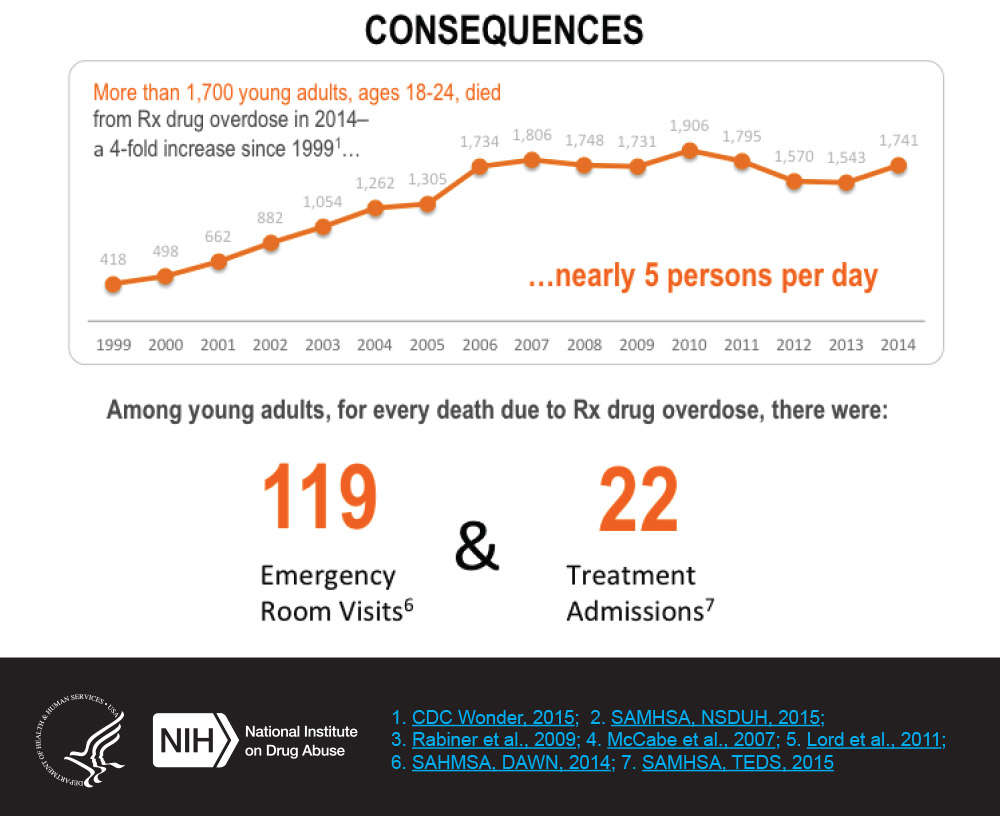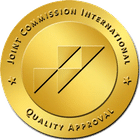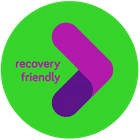Adolescents and young adults are turning to prescription opioids in alarming numbers. From teenagers to early 20s, the prescription drug epidemic is showing no signs of slowing down and is putting our youth in great danger to turn to other illicit opioids, like heroin, down the road. While several prescription drugs are abused, such as benzos, like Xanax, and stimulants like Adderall, prescription opioids are still among the most popular prescription drugs being abused.
Prescription Drug Abuse Statistic in Young Adults
According to the National Institute on Drug Abuse’s study for prescription drug abuse statistics in 2017, an estimated 18 million people have misused prescription drugs at least once in the past year. While an estimated 2 million Americans misused prescription opioids for the first time in the past year. That equates to around 5,480 people a year that may struggle with prescription opioid or other prescription drug addiction.
Misuse of prescription opioids and other prescription drug abuse rates are the highest among young adults, and teens aged 18-25. 14.4% of all 18-25-year-olds report having abused prescription opioids or other prescription drugs in the past year – these numbers reflect what was reported. The chances are that the real number could be higher. While alcohol, marijuana and tobacco use in young adults is still commonplace, prescription drugs taken recreationally has now been added to that list.
Overdose Rates of Young Adults Using Prescription Drugs
Although in recent years, the number of young adults using prescription opioids and other prescription drugs has decreased, in 2014, there were over 1,700 overdose deaths in people aged 18-24 due to prescription drugs. For every overdose death due to prescription opioid and prescription drug abuse, there were 119 emergency room visits and 22 treatment admissions. Prescription opioids mainly caused prescription drug overdose deaths.

While there is addiction treatment available for prescription opioid abuse, many people – especially young adults – can easily justify that using prescription opioids is safe because they come from a doctor. Overdose deaths from prescription opioids are a large number of overdose deaths; the overdoses aren’t confined to illicit street drugs. Young adults and teens that are purchasing prescription opioids on the street, as opposed to taking old prescriptions, or getting them from a friend or family members prescription are at even higher susceptibility to experiencing an overdose. In recent years there has been an explosion of counterfeit prescription opioids that have been laced with fentanyl and carfentanil. Incidents of fake prescription opioids laced with fentanyl have been popping up all over America.
Fentanyl laced counterfeit prescription drugs aren’t limited to only opioids. There have been cases of fake Xanax that is laced with fentanyl as well. Fentanyl is a deadly opioid that is 25-40 times stronger than heroin. Many unsuspecting teens and young adults are buying counterfeit prescription drugs and overdosing, or unknowingly becoming addicted to a much stronger opioid. When opiates are mixed with other depressants, like alcohol, overdoses and other adverse effects are more likely to happen as both substances are depressants on the central nervous system.
Prescription Drug Abuse in High Schools
In three different studies, one conducted by the University of Southern California (USC) and two studies conducted by the University of Michigan (U-M). All studies delivered astronomical and concerning rates of prescription drug abuse in high school-aged students. The opioid epidemic touches all corners of our country, with the studies having been conducted in different areas of the country, it allows us insight into how widespread the epidemic truly is.
Prescription drug addiction is beginning in high school students; this can lead to a lifetime of prescription drug addiction; it’s typically not a “phase,” but a substance use disorder. In the study conducted by the U-M, prescription drug abuse statistics came back that 11% of high school seniors reported prescription drug abuse during the past year, and of that group, 44% used multiple sources to obtain prescription drugs. The study also found that young adults and teens using multiple sources for prescription drugs were at a high for to use other substances, and developing a substance use disorder.
The most common sources for prescription drugs for adolescents aged 12-17 were from friends and family. Most of the prescription drugs being abused were given for free.
The study conducted by USC had equally concerning data. The study showed that teens who use prescription opioids are more likely to start using heroin by high school graduation. 596 students out of 3,300 involved in the study reported that they had used prescription opioids to get high during their first three and a half years of high school. Of those students that reported prescription opioid abuse in the first 3.5 years of school, 13.1% of current prescription opioid users and 10.7% of previous prescription opioid users had used heroin by the end of high school. Another disturbing statistic that came back was 1.7% of student who did not use prescription opioids to get high had tried heroin by the end of high school.
Adam Leventhal, the director of the USC Institute for Addiction Science at the Keck School of Medicine of USC, said “while we can’t definitively conclude that there is a cause-and-effect relation, there may be something unique about opioid drugs that make youths vulnerable to trying heroin. The results do not appear to be driven by the tendency of some teens to act out, rebel, or experiment with many types of drugs.”
The Link Between Teens, Prescription Opioids and Heroin
The brain cannot tell the difference between prescription opioids and illegal street drugs like heroin and fentanyl-laced counterfeit prescription opioids. Opioids all react in the brain similarly. When opioids bind to the opiate receptors in the brain and throughout the body, they relieve pain, but they can also create feelings of euphoria. The feeling of euphoria can be extremely addictive, and the flood of dopamine that accompanies the use of prescription opioids. When someone, especially teens who often feel pressured and stressed, continues to take prescription opioids, they develop a tolerance to the effects and require more prescription opioids to achieve the same effect. Keeping up with a prescription opioid habit can become costly. Trying to maintain an expensive prescription opiate habit is often where many people switch to using heroin in place of prescription opioids because it is cheaper.
Some people become addicted to prescription opioids after a surgery or injury, even when prescription drugs are being taken as prescribed. Depending on the length of the prescription, or the need to alleviate pain, dependence can develop within that time. After the prescription runs out, many are left with uncomfortable withdrawal symptoms that will lead to seeking more opioids, whether they’re prescription opioids or other opiates like heroin.
Teens often live at home; if they are working, they can only have a part-time job due to school. That means that they have limited funds to spend on prescription opioids. If teens have been abusing opiates for an extended amount of time, or have become addicted or physically dependent on them, they may turn to heroin. Heroin is a cheaper alternative to prescription opioids. Heroin is an extremely addictive drug that is bought on the street. Heroin is in no way regulated and is often cut with other substances, like baking soda, talcum powder, powdered milk, and even rat poison. These substances are used as fillers to stretch out batches of heroin to make more profit for dealers. As of late, heroin has also been cut with other substances like fentanyl and carfentanil to increase its potency as well as to cover up any other fillers that have been used.
The correlation between teen prescription opioid abuse and possible heroin use are relatively clear to see.
Treatment for Prescription Drug Abuse
There is treatment available for those who are suffering from prescription drug addiction. GateHouse Treatment can offer varying levels of care, depending on the extent of prescription drug and prescription opioid addiction. Due to the intense withdrawal from prescription opioids, medical detox is usually necessary. While withdrawal from opioids is harsh, opioid detox is not fatal to users. Most people who try to detox on their own from prescription opioids or heroin often return to using to alleviate withdrawal symptoms.
A partial hospitalization program (PHP) is a structured start to entering recovery from prescription drug abuse. GateHouse Treatment offers PHP levels of care, intensive outpatient treatment, and outpatient treatment services to those struggling with prescription opioid addiction. GateHouse also has an integrated 12-step program alongside our clinical approach to addiction treatment. Our 12-step path allows those struggling with prescription opioid addiction to maintain their sobriety outside of a treatment setting. If you or a loved one is struggling with prescription opioid addiction, or other opiate addiction, reach out to us today at 855-448-3588.
- Cymbalta Withdrawal: Causes, Symptoms, And Management - October 12, 2023
- Boredom in Recovery: 5 Tips to Avoid Relapse - October 6, 2023
- Overconfidence and Rehab: Avoiding Relapse - October 4, 2023




